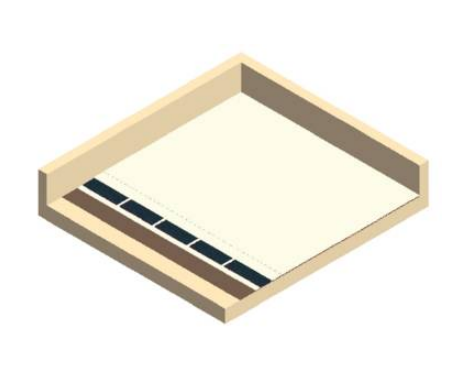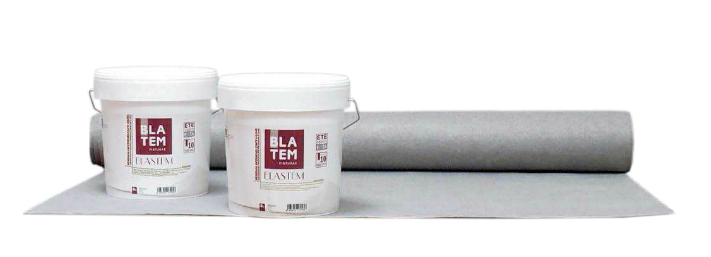
Liquid waterproofing membranes: advantages and preliminary considerations
Construction defects, existence of critical points for waterproofing or wear resulting from rain or snow are often the cause of leaks in roofs and terraces. Without proper treatment, it is only a matter of time before leaks or moisture end up affecting the interior of our homes. As we pointed out in a previous article, there are numerous roof waterproofing systems on the market, but one is prevailing due to its versatility and quality/price value. We're speaking of liquid waterproofing membranes. What is behind this innovative product?
Liquid waterproofing membranes are applied like paint, upon drying, they form an elastic membrane with excellent waterproofing capability. Manufacturers of waterproofing solutions have developed several of these membranes from numerous compounds such as cement, silicone resins, acrylic copolymers, polyurethanes or bituminous and asphalt waterproofing agents.
However, which would be the most suitable for each application? Prior to selecting one solution or another, one must consider that not all liquid membranes are suitable for all surfaces; nor are all membranes suitable for all roof uses.
What must I consider prior to selecting a liquid membrane solution?
Transitability: for roofs subject to the passage of persons, liquid waterproofing with high resistance to pedestrian traffic would be applied, such as water-based polyurethane membranes.
Selection of suitable primer for each surface.
Level of protection of the system. Many systems may consist of heavy protective layers as well as finish layers that prevent separation from the support and protect it from environmental agents and mechanical damage.
Compatibility of materials: The technical characteristics of the membrane must be taken into consideration in order to ensure that it will support the weight of the covering. The materials must be compatible. For example, tile may not be used to cover a liquid membrane if it is not resistant to cement alkalis, as it would degrade and eventually destroy it. In addition to this factor, during application of the system, damage to the membrane must be prevented when applying the covering. This could occur when applying mortar with a trowel, if the liquid membrane is cut.
Insulation capability. The insulating properties of liquid waterproofing membranes are not features of their composition; i.e. they do not depend on whether they are acrylic, polyurethane or any other component. In and of themselves, these compounds have no significant insulating properties. This potential advantage depends on the pigment technology associated with colours.
Application requirements: Another fundamental aspect is to understand the circumstances under which application of each membrane is not recommendable. For example, frequently, there are limitations due to low temperatures. Additionally, application on surfaces with extreme insolation can be critical.
Primary advantages of liquid waterproofing membranes
Easy application: this product is applied as any other paint, with brush, roller or spray gun. It can also be easily applied to vaulted or steeply inclined roofs.
High elasticity. On surfaces such as terraces with direct exposure to sunlight, thermal expansion is a problem that directly affects products for the waterproofing of terraces. Elasticity of liquid membranes prevents cracks and other defects that may compromise their quality.
Long useful life: Waterproofing properties extend over time without decreasing their effectiveness. In fact, regular maintenance is not necessary as with other solutions. These advantages are associated with its high resistance to weathering, ageing and ultraviolet radiation,

The Blatem Elastem System
As a result of decades of experience in the field of rehabilitation and waterproofing, Pinturas Blatem has developed its own unique system based on the advantageous properties of liquid membranes: the Elastem system. This solution offers waterproofing treatment, which also provides thermal-reflective properties for roofs and any exterior surface, reducing the transmission of heat into the interior of the house. Elastem is very versatile and is designed for application on concrete, mortar, fibre cement, terrazzo, bituminous, asphalt, metal (iron, galvanized steel or iron, aluminium), etc.
Composed of special acrylic copolymers, Elastem provides a smooth semi-gloss appearance and is available in white, red, grey, green and terracotta. Additionally, the system incorporates a geotextile reinforcement mesh manufactured using 100% high tenacity polypropylene staple fibres. This enables separation of the liquid membrane from its covering, as well as protection of the membrane from mechanical damage, puncture or abrasion.
Reinforced system with the latest technology
Beyond waterproofing, whenever additional characteristics are required, such as a walkable surface (transitability), a reinforcement layer must be incorporated. This reinforcement layer generally consists of high-strength fibres, such as glass, polyester and polypropylene. In general, these reinforcement layers provide greater resistance to liquid waterproofing with a given thickness.
In many cases, the use of reinforcements is practically mandatory; for singular points on the roof, for the repair of cracks or for walkable surfaces, such as terraces.

The distinctive feature of the Elastem 180 mesh from Blatem is that the mesh to use is specific for this system. It may not always be possible to select any type of mesh, such as fibreglass, which is generally the most available. The mesh offered with the Blatem Elastem system has been tested jointly with the liquid waterproofing, so that they work together while providing optimal technical characteristics. In short, this is a liquid waterproofing system, and not simply a liquid membrane incorporating any reinforcement mesh with uncertain results.




















